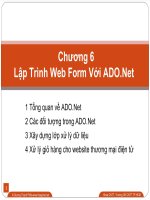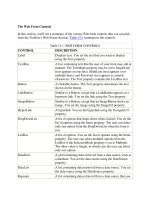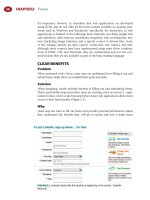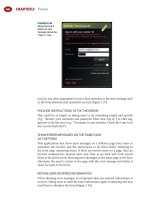web form design
Bạn đang xem bản rút gọn của tài liệu. Xem và tải ngay bản đầy đủ của tài liệu tại đây (13.32 MB, 373 trang )
W E B F ORM DE S I GN
Filling in the Blanks
by LUKE WROBLEWSK I foreword by Jared Spool
Forms make or break the most crucial online interactions: checkout,
registration, and any task requiring information entry. In Web Form
Design, Luke Wroblewski draws on original research, his considerable
experience at Yahoo! and eBay, and the perspectives of many of the
field’s leading designers to show you everything you need to know about
designing effective and engaging web forms.
“Luke Wroblewski has done the entire world a great favor by writing this book. With deft explanations
and clear examples, he presents a clear case for better Web forms and how to achieve them. This
book will help you every day.”
ALAN COOPER
Chairman
Cooper
“If I could only send a copy of Web Form Design to the designer of every web form that’s frustrated
me, I’d go bankrupt from the shipping charges alone. Please. Stop the pain. Read this book now.”
ERIC MEYER
Author of CSS: The Definitive Guide
meyerweb.com
“Luke’s book is by far the most practical, comprehensive, data-driven guide for solving form design
challenges. It is an essential reference that will become a must-read for many years.”
IRENE AU
Director, User Experience
Google
www.rosenfeldmedia.com
MORE ON WEB FORM DESIGN
www.rosenfeldmedia.com/books/webforms/
W E B F OR M D E S I G N by LUKE WROBLEWSK I
WEB FORM DESIGN
FILLING IN THE BLANKS
by: Luke Wroblewski
Rosenfeld Media
Brooklyn, New York
Enter code WFDDE for 10% o any Rosenfeld Media product directly
purchased from our site:
Download from Library of Wow! eBook
www.wowebook.com
TABLE OF CONTENTS
How to Use This Book x
Who Should Read This Book? xi
What’s in the Book? xii
What Comes with the Book? xv
Frequently Asked Questions xviii
Foreword
xxiii
Form Structure
CHAPTER 1
The Design of Forms 1
Form Design Matters 5
The Impact of Form Design 16
Design Considerations 27
CHAPTER 2
Form Organization 31
What to Include 32
Have a Conversation 37
Organizing Content 40
Group Distinctions 48
Best Practices 56
ii
Table of Contents
CHAPTER 3
Path to Completion 59
Name That Form 60
Start Pages 62
Clear Scan Lines 64
Minimal Distractions 68
Progress Indicators 70
Tabbing 81
Best Practices 85
Form Elements
CHAPTER 4
Labels 86
Label Alignment 87
Top-Aligned Labels 89
Right-Aligned Labels 94
Left-Aligned Labels 96
Labels Within Inputs 99
Mixed Alignments 102
Best Practices 104
CHAPTER 5
Input Fields 106
Types of Input Fields 107
Field Lengths 116
Required Fields 119
iii
Table of Contents
TABLE OF CONTENTS
Input Groups 131
Flexible Inputs 132
Best Practices 136
CHAPTER 6
Actions 138
Primary and Secondary Actions 139
Placement 147
Actions in Progress 150
Agree and Submit 155
Best Practices 158
CHAPTER 7
Help Text 160
When to Help 161
Automatic Inline Help 166
User-Activated Inline Help 173
User-Activated Section Help 178
Secure Transactions 182
Best Practices 184
CHAPTER 8
Errors and Success 186
Errors 187
Success 205
No Dead Ends 211
Best Practices 212
iv
Table of Contents
TABLE OF CONTENTS
Form Interaction
CHAPTER 9
Inline Validation 214
Confirmation 215
Suggestions 225
Limits 228
Best Practices 230
CHAPTER 10
Unnecessary Inputs 231
Removing Questions 232
Smart Defaults 239
Personalized Defaults 246
Best Practices 248
CHAPTER 11
Additional Inputs 249
Inline Additions 250
Overlays 254
Progressive Engagement 265
Best Practices 269
v
Table of Contents
TABLE OF CONTENTS
CHAPTER 12
Selection-Dependent Inputs 271
Page-Level Selection 276
Horizontal Tabs 279
Vertical Tabs 282
Drop-Down List 285
Expose Below Radio Buttons 287
Expose Within Radio Buttons 290
Exposed Inactive 292
Exposed Groups 295
Best Practices 299
CHAPTER 13
Gradual Engagement 302
Signing Up 303
Getting Engaged 306
Best Practices 316
CHAPTER 14
What’s Next? 317
The Disappearing Form 318
The Changing Form 321
Getting It Built 329
vi
Table of Contents
TABLE OF CONTENTS
Index 331
Acknowledgments 342
About the Author 344
vii
Table of Contents
TABLE OF CONTENTS
Web Form Design: Filling in the Blanks
By Luke Wroblewski
Rosenfeld Media, LLC
705 Carroll Street, #2L
Brooklyn, New York
11215 USA
On the web: www.rosenfeldmedia.com
Please send errors to:
Publisher: Louis Rosenfeld
Editor/Production Editor: Marta Justak
Interior Layout: Susan Honeywell
Cover Design: The Heads of State
Indexer: Nancy Guenther
Proofreader: Chuck Hutchinson
© 2008 Rosenfeld Media, LLC
All Rights Reserved
ISBN: 1-933820-25-X
ISBN-13: 978-1-933820-25-5
Library of Congress Control Number: 2008923241
Printed and bound in the United States of America
For everyone who has had to ll in a form.
HOW TO USE THIS BOOK
Web form design. Do we really need an entire
book on such a mundane topic?
You bet we do. As arbiters of checkout,
registration, and data entry, Web forms
are often the lynchpins of successful Web
applications.
• Checkout forms are how ecommerce
vendors close deals—they stand between
people and the products or services they
want and between companies and their
prots. For example, eBay’s vast inventory
(it’s the 30th largest economy in the world)
is driven in no small part by its Sell Your
Item form.
• Registration forms are the gatekeepers
to community membership—they allow
people to dene their identity within social
applications. All of MySpace’s 150+ million
users joined through a Web form.
x
How to Use this Book
• Data input forms allow users to contribute
or share information, and they allow
companies to grow their content. Most of
YouTube’s huge video collection comes
from its Upload Your Video form.
Web forms are often the last and most
important mile in a long journey. Despite
their importance, the design of forms is often
poorly thought out and conceived. Your
organization may have already invested heavily
in opening a relationship with its customers
through high-quality marketing, site design,
and search engine optimization. But now it is
time to “close the deal” by making sure those
customers can complete your forms. And that’s
where this book will help.
Who Should Read this Book?
Web Form Design: Filling in the Blanks is truly
for anyone who needs to design or develop
HOW TO USE THIS BOOK
xi
How to Use this Book
Web forms—and who doesn’t? Whatever type
of designer you are—usability engineer, Web
developer, product manager, visual designer,
interaction designer, or information architect—
you’re probably involved in Web form design
in some fashion. This book will provide you
with something that you can use immediately
to improve your site’s forms.
If you’re a beginner, you’ll receive a broad
overview of all the considerations that
constitute good form design. If you’re an
experienced practitioner, you’ll engage at a
deeper level with issues and solutions you may
not have encountered before.
What’s in the Book?
This book is a collection of the insights
and best practices for Web form design I’ve
accumulated through 12 years of designing
Web experiences. Wherever possible, I’ve
HOW TO USE THIS BOOK
xii
How to Use this Book
conducted or referenced research to better
understand the impact of Web form design
decisions. Where no research was available,
I’ve called on my own experiences and those of
other designers and developers.
Just about every chapter in this book wraps up
with a set of best practices that outline ways
you can begin to apply the key points made
within each chapter. Although these best
practices can guide you toward the right design
solutions for your forms, the content within
each chapter explains the what, when, and
why that informs each best practice.
Section One, “Form Structure,” begins
with an overview of why form design matters
and the principles behind good form design.
The remaining chapters provide a set of best
practices for organizing forms and focusing
people on their primary goal of completing a
form.
HOW TO USE THIS BOOK
xiii
How to Use this Book
Chapter 1: Design of Forms
Chapter 2: Form Organization
Chapter 3: Path to Completion
Section Two, “Form Elements,” dives into a
series of best practices for the core components
that make up forms: labels, input elds,
actions, and messaging (help, errors, success).
Here you will nd information on aligning
labels, required input elds, primary versus
secondary actions, automatic help systems, and
much more.
Chapter 4: Labels
Chapter 5: Input Fields
Chapter 6: Actions
Chapter 7: Help Text
Chapter 8: Errors and Success
Section Three, “Form Interaction,” focuses
on the process of lling in forms. From inline
validation solutions that conrm or suggest
valid answers to gradual engagement solutions
HOW TO USE THIS BOOK
xiv
How to Use this Book
that immerse people within a Web experience
without forms, this section is about applying
dynamic behavior to make forms more useful,
usable, and enjoyable.
Chapter 9: Inline Validation
Chapter 10: Unnecessary Inputs
Chapter 11: Additional Inputs
Chapter 12: Selection-Dependent Inputs
Chapter 13: Gradual Engagement
Chapter 14: What’s Next?
What Comes with the Book?
This book’s companion Web site (
http://
www.rosenfeldmedia.com/books/
webforms) contains pointers to useful
Web form design articles that I’ve found and
I’ve also written. It includes a calendar of my
upcoming talks, and a place for you to engage
in discussion with others interested in Web
form design. We expect to post information
on new Web form design-related resources
HOW TO USE THIS BOOK
xv
How to Use this Book
and special discounts for related applications.
You can keep up with the site by subscribing
to its RSS feed ( http://feeds.
rosenfeldmedia.com/webforms/)
We’ve also made the book’s diagrams,
screenshots, and other illustrations available
under a Creative Commons license for you to
download and use in your own presentations.
You’ll nd them in Flickr (http://www.
flickr.com/photos/rosenfeldmedia).
We recommend that you display the digital
version of the book using a recent version of
Adobe’s Reader or Acrobat Professional, which
support live links. That way you can jump to
other parts of the book (i.e., from the table of
contents to a specic section) and to external
web pages (such as the large, high-resolution
version of each of the book’s illustrations,
which we’ve made available via Flickr) by
simply clicking. You’ll also nd navigation
HOW TO USE THIS BOOK
xvi
How to Use this Book
easier if you display the Navigation Pane (in
Apple’s Preview reader, the Drawer).
We’ve optimized the digital version of this
book for being read and used on a computer.
As digital books are still quite a new
phenomenon, we’d love your suggestions for
how to improve our digital design; please
contact us at
HOW TO USE THIS BOOK
xvii
How to Use this Book
Why does Web form design matter?
Forms enable commerce, communities, and
productivity on the Web to thrive. If you are
in online retail, your goal is to sell things.
But standing in the way of your products and
your customers is a checkout form. If you are
developing social software, your goal is to grow
your community. Standing in between you and
community members is a form. If you’ve built
a productivity-based Web application, forms
enable key interactions that let people create
and manage content. See page 5 for more
information.
How should I organize my Web form—within
one Web page or across several?
Who is lling the form in and why? Answering
this up front allows us to think about our
forms as a deliberate conversation instead of
the inputs for a database. When you approach
forms as a conversation, natural breaks will
emerge between topics. When these distinct
FREQUENTLY
ASKED QUESTIONS
xviii
Frequently Asked Questions
topics are short enough to t into a few
sections, a single Web page will probably work
best to organize them. When each section
begins to run long, multiple Web pages may
be required to break up the conversation into
meaningful, understandable topics. See
page 40.
If my form spans several Web pages, do I tell
people what page they’re on?
When the questions that need to be answered
before a Web form is complete are spread
across multiple Web pages, you may want to
include an overview of the number of Web
pages involved (scope), an indication of
what page you are on (position), and a way
to save and return to your progress (status).
Though closely integrated, these three progress
indicators perform different functions. See
page 70.
FREQUENTLY
ASKED QUESTIONS
xix
Frequently Asked Questions
Should I top-, right-, or left-align the labels for
input fields?
When you are trying to reduce completion
times or if you need exible label lengths for
localization, consider top-aligned labels. When
you have similar goals but vertical screen
real estate constraints, consider right-aligned
labels. When your form requires people to scan
labels to learn what’s required or to answer a
few specic questions out of many, consider
left-aligned labels. See page 87.
How are smart defaults used in Web forms?
Smart defaults can help people answer
questions by putting default selections in place
that serve the interests of most people. There
are many opportunities within Web forms to
utilize the power of smart defaults to reduce the
number of choices people have to make and
thereby expedite form completion. See page
239.
FREQUENTLY
ASKED QUESTIONS
xx
Frequently Asked Questions
When should I include help text on my forms?
You should consider adding help text when:
forms ask for unfamiliar data; people question
why they are being asked for specic data;
people may be concerned about the security or
privacy of their data; there are recommended
ways of providing data; and certain data elds
are optional or required when the bulk of the
form is not. See page 164.
How should I indicate required input fields?
If most of the inputs on a form are required,
indicate the few that are optional. If most of the
inputs on a form are optional, indicate the few
that are required. When indicating what form
elds are either required or optional, text is the
most clear. However, the * symbol is relatively
well understood to mean required.
See page
119.
FREQUENTLY
ASKED QUESTIONS
xxi
Frequently Asked Questions
What’s the dierence between a primary and
secondary action?
Actions such as Submit, Save, or Continue
are intended to enable completion, which is
the primary goal of just about anyone who has
started lling in a form. As a result, they are
often referred to as primary actions. Secondary
actions, on the other hand, tend to be less
utilized. See page 139.
FREQUENTLY
ASKED QUESTIONS
xxii
Frequently Asked Questions
I’m sorry to break this to you, but your life is
about to change.
I know this because of a study we conducted
years ago when we had the opportunity to
observe Master Cabinetmakers. What does
building kitchen cabinets have to do with
designing forms in an online application? Let
me explain…
The purpose of our study was to look at the
difference between those who do mediocre
work and those whose work is excellent. We
picked a variety of trades to study, where we
could nd people who were true masters. We
wanted to see the differences between the
masters’ work and those of people whose skills
weren’t as rened.
This brought us to cabinetmakers. Cabinetry
is a very old craft, and the people who master
it are amazing in their talents and skills. They
FOREWORD
xxiii
Foreword
can create something that is both useful and
beautiful. The best are aware their products
are only a piece of the overall décor and know
how to blend their results perfectly into the
surrounding experience. After all, when we’re
in the kitchen, it’s about the cooking and
the family interaction—not about eternal
admiration of the dovetail joints holding the
utensils in place.
One of the biggest takeaways from our research
was the carpenters’ extreme attention to detail.
Even though each person we interviewed
had years of experience, nothing was taken
for granted. Every hinge and joint was nely
crafted, almost as if it were the most important
element in their entire career. The pride they
took in the nal cabinet was the sum of the
pride they took in each individual element.
Cabinetmakers aren’t the only folks who
behave this way. So are the master craftsmen of
FOREWORD
xxiv
Foreword









